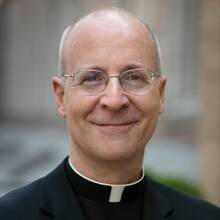Some people believe that Jesuits can be characterized as follows: We all have doctorates; we all know the pope personally; and we all travel to Rome frequently. But, like many Jesuits, I do not have a Ph.D.; I’ve never met the pope; and the last time I was in Rome was decades ago—in 1994, on my way home from a two-year stay in Kenya.
That was true until June. Last year, a Jesuit friend invited me to assist as a spiritual guide on a pilgrimage to Rome for a group of 40 adults connected to two Jesuit high schools. It would be an “Ignatian pilgrimage,” that is, focusing on sites that figure in the life of St. Ignatius Loyola.
When my friend first invited me, I warned him that I knew little about Rome. I imagined myself among a group of American tourists in the middle of a busy piazza with tiny cars buzzing around us, and saying, “St. Peter’s Square? Gee, I’m sure it’s around here somewhere.”
“Don’t worry,” said my friend, “all you have to do is offer a spiritual reflection at the beginning of our day. The tour guide and I will take care of the rest.”
The pilgrimage this summer was enormous fun. Our group stayed in a pleasant hostel not far from the Vatican walls, we were able to get within 10 feet of Pope Francis during his weekly outdoor audience (along with 50,000 of the pope’s closest friends) and spent an entire day in Assisi, a town that is like one, big outdoor church.
At one point, we visited the Catacombs of St. Sebastian, outside the Roman walls. Near the end of our tour, we saw a sizeable tomb decorated with remarkably well-preserved drawings. On one side was a group of people, on the other a man carrying something indistinct. “That’s the ‘Feeding of the Multitudes,’” said our guide, “and the ‘Good Shepherd.’ From the second century.” There we stood, in front of the creation of someone from the earliest days of the church: I felt an almost electric shock of connection.
Even after the official pilgrimage ended, there were many graces. Providentially, my sister’s family was on vacation in Italy, and my friend and I stayed a few days longer to spend time with her, her husband and my two nephews, ages 8 and 15. It was a joy to see so many Catholic sites through the eyes of my nephews and to witness their interest in St. Ignatius, whom they know by now. This year Charles, the older brother, chose Ignatius as his confirmation name—with no pressure from his uncle. Their interest, however, manifested itself in surprising ways: in the rooms of St. Ignatius, alongside a bronze bust of the saint, they took selfies.
Not everything about our church, I was reminded, is easy to understand. One day we visited the Church of the Gesù, the mother church of the Jesuit Order. After entering, I led Matthew and Charles to an ornate altar. “That’s where St. Ignatius is buried,” I said. “Really? Right here?” said Matthew. We prayed before his tomb.
Across the aisle was an altar that would need more explanation. “Matthew,” I said, “do you know who St. Francis Xavier was?” He shook his head. I explained that Francis was Ignatius’s best friend. “Uh huh,” he said. And Francis Xavier went around the world to preach the Gospel. “Uh huh.” I pointed to a golden reliquary above the altar and said, “And that’s his right arm.”
“Wait—that’s his arm?” said my nephew. “Why is it here?” I explained that it was a special part of his body because it had baptized many people during his travels.
“Where’s the rest of him?” Goa, a city in India. “Why is it there?” They liked Francis very much in India, I explained, so they kept his body and sent his arm here.
With wide eyes, Matthew looked at the arm, and then at me, and then back at the arm. Then he said, “That makes me very uncomfortable!”
In the coming years, I’m not sure how much my nephews will recall about their visit to Rome. I’ll remember coming face to face with those haunting drawings in the catacombs, seeing the pope wave to our group in St. Peter’s Square, and praying with my family in the room where St. Ignatius died. I hope that in some way the trip helped my nephews connect with the astonishing story of their faith, especially with those Christians who came before us—what they did, prayed, created and suffered.
One of them will certainly remember St. Francis Xavier—or, at the very least, a part of him.








